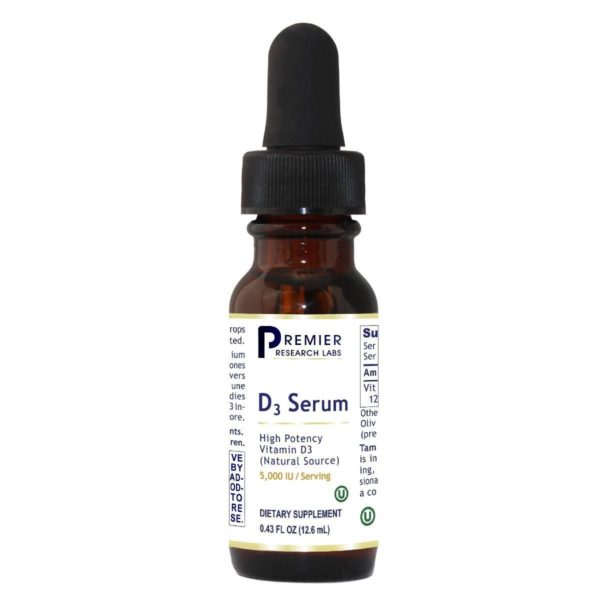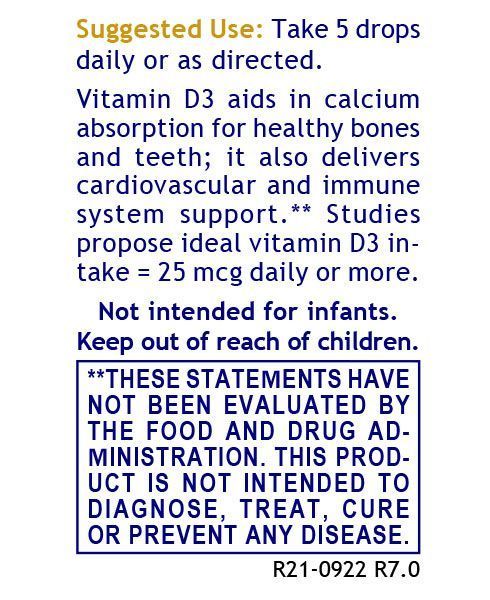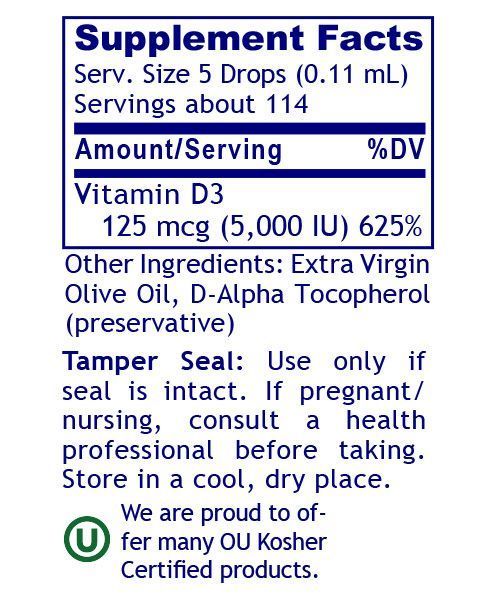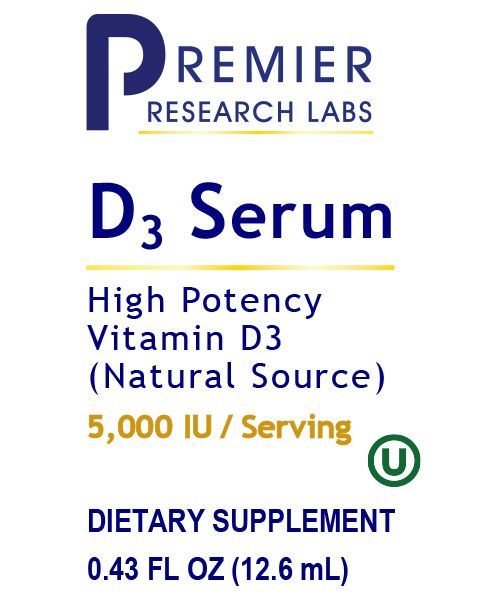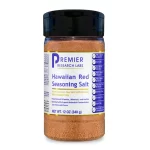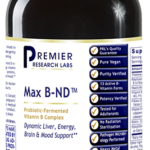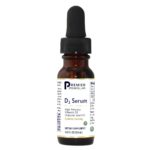$16.96
D3 Serum – from Premier Research Labs
- 5,000 IU vitamin D3 per dose
- Nature-sourced vitamin D3 (not synthetic) in a fat-soluble base for better absorption
- No artificial colors or flavors, no added magnesium stearate
- Promotes bone growth and mineralization, absorption of calcium
- Supports cardiovascular and immune system health
D3 Serum is the healthiest, natural vitamin D3. It is crucial for the absorption of calcium in the body, so it supports alkaline pH, healthy bones, nerves, heart, brain, lungs, breasts, colon, stomach, pancreas, prostate, uterus, ovaries & kidneys. See our Alkaline pH page for more suggestions and an alkaline diet description.
How can you get vitamin D?
Vitamin D is one of the few nutrients the body needs, that does not come from a wide variety of foods. Although salmon, mackerel, sardines and tuna can deliver about 200 I.U./serving, they are not an adequate source of D3. After fortification, milk delivers only vitamin D2 – not D3, the real thing. Vitamin D2 is also added to fortified dairy products but does not function in the same way as D3. Vitamin D3 can be more than 3 times as effective as D2 in maintaining and raising vitamin D blood levels. Although vitamin D3 is more expensive to produce, it is clearly superior to D2. That’s why we only use D3 in our D3 Serum.
In fact, only one specific source of D3 has met all four of our criteria:
(1) it is live source,
(2) has no toxic tagalongs,
(3) tests onto all four polarities, and
(4) it tests so strong that its biofield cannot be stress-tapped off even at 100+ stress-taps. (As a point of reference, we have found that the biofield of even the best organically grown American food typically stress-taps off at only 5 stress-taps.)
The body was designed to manufacture a sufficient amount of vitamin D simply by skin exposure to sunlight, which converts 7-dehydrocholesterol to cholecalciferol. Cholecalciferol in turn is hydroxylated at the liver forming 25(OH) D. At the kidneys, 25(OH)D is metabolized to the most active form of vitamin D 1,25(OH)2D3. Sadly, we as a nation do not spend much time in sunlight and when we do, our skin is mostly covered. As a consequence, most people have low levels of vitamin D3 which has initiated a ground swell of scientific research calling for increased daily vitamin D3 intake for all Americans.
In 1941, the RDA (recommended dietary allowance) of vitamin D was 400 I.U./day to prevent D deficiency and rickets. Today, scientists are calling for an increase in this daily intake, recommending 1,000 to 2,000 I.U./day. They believe these levels can best provide the support for the body’s critical vitamin D needs now identified to include immunological, vascular, cognitive, mucosal and reproductive health and more.
Experts now consider vitamin D3blood levels less than 20ng/ml to be frank D3 deficiency, while 20-39ng/ml is still too low; 40-50ng/ml is considered to be reasonable but not ideal. At all of these levels, supplementation with D3 is recommended at 5,000 to 7,000 I.U./day for 6-8 weeks. Ideally, the individual would be re-tested every 3 months until their blood levels are in the ideal range (i.e. D3 levels greater than 50ng/ml but less than 60ng/ml).
Some experts believe the upper limit of vitamin D intake should be 2,000 to 10,000 I.U./day. However, when vitamin D blood levels are greater than 200ng/ml, a toxic reaction could potentially lead to hypercalcemia/ hyperphosphatemia. Hypercalcemia is rare but could be triggered by D3 intake of over 50,000 I.U./day. In published cases of vitamin D toxicity, intake was greater than 400,000 I.U./day. Common signs of hypercalcemia are anorexia, nausea and vomiting.
Key Benefits of Live-Source Vitamin D3
Immunity – Population groups with greater direct sunlight exposure or more vitamin D3 exposure, were found to have stronger immune function than those with restricted sunlight exposure. Vitamin D3 receptors are known to exist on most immune cells and play a role in maintaining healthy immune cell maturity, differentiation and integration.
Breast and Mucosal Organs – Research indicates optimal serum levels of vitamin D3 may be important in maintaining the best health of the cells of the breasts, lungs, colon, esophagus, stomach, pancreas, bladder, prostate, uterus, ovaries and kidneys.
Bone Metabolism – In a 3-year randomized controlled study, vitamin D3 and calcium supplementation promoted bone strength and reduced risk of falling in women aged 65 or older. Vitamin D3 supplements were shown to support hip and non-vertabral bone health in a meta-analysis of twelve double-blind randomized controlled trials of 20,000 people. Vitamin D is essential for healthy calcium metabolism; it promotes intestinal calcium and phosphorus uptake and can reduce urinary calcium excretion.
Nerve Function – Research indicates vitamin D may promote neural health by supporting healthy nerve conduction potential, antioxidant defense and neuronal calcium regulation. High circulating blood levels of end-chain vitamin D3, 25- hydroxyvitamin D, were associated with nerve and myelin health in a study of 7 million U.S. military personnel, published in JANA, 2006.
Cognition – Higher levels of vitamin D were correlated with healthy mood and mental function in two studies of more than 300 elderly people. Additionally, we now know that vitamin D receptors and vitamin D hydroxylation pathways exist in areas of the brain responsible for memory and cognition.
Heart Health – Healthy blood vessel relaxation and blood flow are associated with ideal levels of vitamin D3. Healthy inflammatory response, antioxidant defense and cytokine production are associated with optimal blood levels of vitamin D as well.
Take 5 drops daily with your largest protein meal of the day. It is recommended to have your blood levels monitored regularly to make sure you aren’t taking too little or too much over a long period of time. If you are pregnant or lactating, consult a physician before use.
Serving Size: 5 Drops (.11 mL) – Servings Per Container: about 114
Each Serving Provides:
Vitamin D3 – 5,000 IU (125 mcg)
Other Ingredients: Extra Virgin Olive Oil, D-Alpha Tocopherol
- Description
- Product Ingredients
- Recommended Use
Description
D3 Serum – from Premier Research Labs
- 5,000 IU vitamin D3 per dose
- Nature-sourced vitamin D3 (not synthetic) in a fat-soluble base for better absorption
- No artificial colors or flavors, no added magnesium stearate
- Promotes bone growth and mineralization, absorption of calcium
- Supports cardiovascular and immune system health
D3 Serum is the healthiest, natural vitamin D3. It is crucial for the absorption of calcium in the body, so it supports alkaline pH, healthy bones, nerves, heart, brain, lungs, breasts, colon, stomach, pancreas, prostate, uterus, ovaries & kidneys. See our Alkaline pH page for more suggestions and an alkaline diet description.
How can you get vitamin D?
Vitamin D is one of the few nutrients the body needs, that does not come from a wide variety of foods. Although salmon, mackerel, sardines and tuna can deliver about 200 I.U./serving, they are not an adequate source of D3. After fortification, milk delivers only vitamin D2 – not D3, the real thing. Vitamin D2 is also added to fortified dairy products but does not function in the same way as D3. Vitamin D3 can be more than 3 times as effective as D2 in maintaining and raising vitamin D blood levels. Although vitamin D3 is more expensive to produce, it is clearly superior to D2. That’s why we only use D3 in our D3 Serum.
In fact, only one specific source of D3 has met all four of our criteria:
(1) it is live source,
(2) has no toxic tagalongs,
(3) tests onto all four polarities, and
(4) it tests so strong that its biofield cannot be stress-tapped off even at 100+ stress-taps. (As a point of reference, we have found that the biofield of even the best organically grown American food typically stress-taps off at only 5 stress-taps.)
The body was designed to manufacture a sufficient amount of vitamin D simply by skin exposure to sunlight, which converts 7-dehydrocholesterol to cholecalciferol. Cholecalciferol in turn is hydroxylated at the liver forming 25(OH) D. At the kidneys, 25(OH)D is metabolized to the most active form of vitamin D 1,25(OH)2D3. Sadly, we as a nation do not spend much time in sunlight and when we do, our skin is mostly covered. As a consequence, most people have low levels of vitamin D3 which has initiated a ground swell of scientific research calling for increased daily vitamin D3 intake for all Americans.
In 1941, the RDA (recommended dietary allowance) of vitamin D was 400 I.U./day to prevent D deficiency and rickets. Today, scientists are calling for an increase in this daily intake, recommending 1,000 to 2,000 I.U./day. They believe these levels can best provide the support for the body’s critical vitamin D needs now identified to include immunological, vascular, cognitive, mucosal and reproductive health and more.
Experts now consider vitamin D3blood levels less than 20ng/ml to be frank D3 deficiency, while 20-39ng/ml is still too low; 40-50ng/ml is considered to be reasonable but not ideal. At all of these levels, supplementation with D3 is recommended at 5,000 to 7,000 I.U./day for 6-8 weeks. Ideally, the individual would be re-tested every 3 months until their blood levels are in the ideal range (i.e. D3 levels greater than 50ng/ml but less than 60ng/ml).
Some experts believe the upper limit of vitamin D intake should be 2,000 to 10,000 I.U./day. However, when vitamin D blood levels are greater than 200ng/ml, a toxic reaction could potentially lead to hypercalcemia/ hyperphosphatemia. Hypercalcemia is rare but could be triggered by D3 intake of over 50,000 I.U./day. In published cases of vitamin D toxicity, intake was greater than 400,000 I.U./day. Common signs of hypercalcemia are anorexia, nausea and vomiting.
Key Benefits of Live-Source Vitamin D3
Immunity – Population groups with greater direct sunlight exposure or more vitamin D3 exposure, were found to have stronger immune function than those with restricted sunlight exposure. Vitamin D3 receptors are known to exist on most immune cells and play a role in maintaining healthy immune cell maturity, differentiation and integration.
Breast and Mucosal Organs – Research indicates optimal serum levels of vitamin D3 may be important in maintaining the best health of the cells of the breasts, lungs, colon, esophagus, stomach, pancreas, bladder, prostate, uterus, ovaries and kidneys.
Bone Metabolism – In a 3-year randomized controlled study, vitamin D3 and calcium supplementation promoted bone strength and reduced risk of falling in women aged 65 or older. Vitamin D3 supplements were shown to support hip and non-vertabral bone health in a meta-analysis of twelve double-blind randomized controlled trials of 20,000 people. Vitamin D is essential for healthy calcium metabolism; it promotes intestinal calcium and phosphorus uptake and can reduce urinary calcium excretion.
Nerve Function – Research indicates vitamin D may promote neural health by supporting healthy nerve conduction potential, antioxidant defense and neuronal calcium regulation. High circulating blood levels of end-chain vitamin D3, 25- hydroxyvitamin D, were associated with nerve and myelin health in a study of 7 million U.S. military personnel, published in JANA, 2006.
Cognition – Higher levels of vitamin D were correlated with healthy mood and mental function in two studies of more than 300 elderly people. Additionally, we now know that vitamin D receptors and vitamin D hydroxylation pathways exist in areas of the brain responsible for memory and cognition.
Heart Health – Healthy blood vessel relaxation and blood flow are associated with ideal levels of vitamin D3. Healthy inflammatory response, antioxidant defense and cytokine production are associated with optimal blood levels of vitamin D as well.
Product Ingredients
Serving Size: 5 Drops (.11 mL) – Servings Per Container: about 114
Each Serving Provides:
Vitamin D3 – 5,000 IU (125 mcg)
Other Ingredients: Extra Virgin Olive Oil, D-Alpha Tocopherol
Take 5 drops daily with your largest protein meal of the day. It is recommended to have your blood levels monitored regularly to make sure you aren’t taking too little or too much over a long period of time. If you are pregnant or lactating, consult a physician before use.

